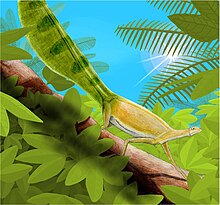| Hypuronector Temporal range: Late Triassic, | |
|---|---|
 | |
| Live restoration as an arboreal reptile | |
 | |
| Skeletal diagram. Scale bar = 1 cm | |
| Scientific classification | |
| Domain: | Eukaryota |
| Kingdom: | Animalia |
| Phylum: | Chordata |
| Class: | Reptilia |
| Clade: | † Drepanosauromorpha |
| Family: | † Drepanosauridae |
| Genus: | † Hypuronector Colbert & Olsen, 2001 |
| Species: | †H. limnaios |
| Binomial name | |
| †Hypuronector limnaios Colbert & Olsen, 2001 | |
Hypuronector is a genus of extinct drepanosaur reptile from the Late Triassic Lockatong Formation of New Jersey. The etymology of the name translates as "deep-tailed swimmer from the lake", in reference to its assumed aquatic habits hypothesized by its discoverers. [1] Hypuronector was related to the arboreal Megalancosaurus . It was a small animal, estimated to be only 12 cm (4.7 in) long in life. So far dozens of specimens of Hypuronector are known, though scientists have not found any complete skeletons. This makes attempts to reconstruct Hypuronector's body or lifestyle highly speculative and controversial.





